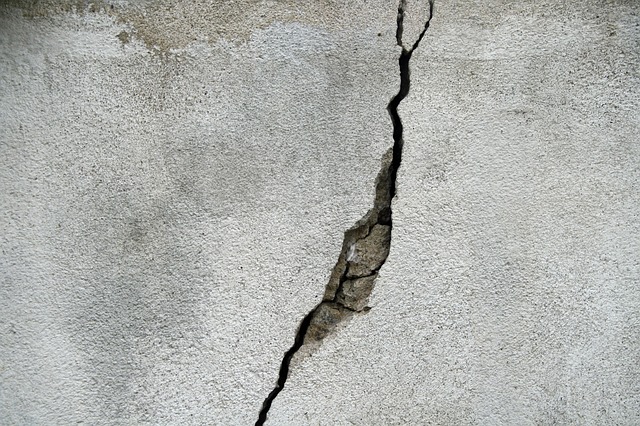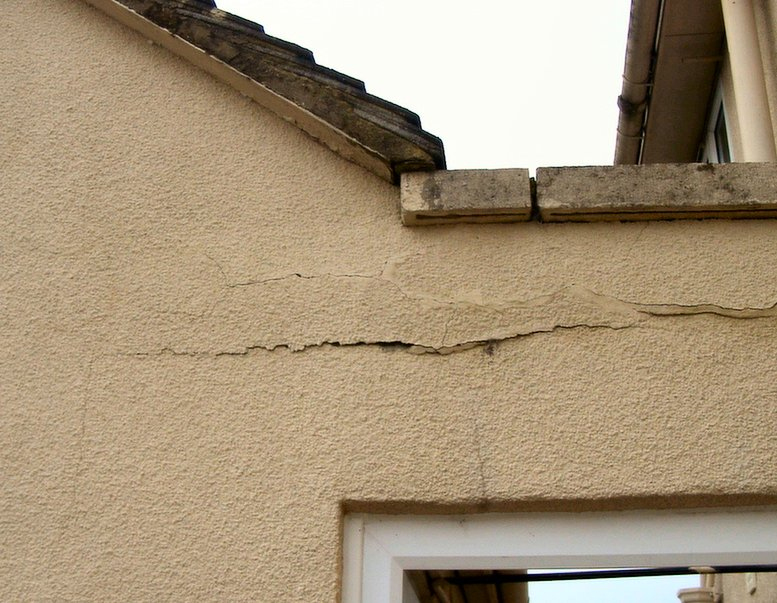Cracking and building movement
[edit] When should I be concerned about building cracks?
Buildings and other built structures are moving all the time, but usually these movements are so small as to be unnoticeable. This movement can be caused by defects, changes in ground conditions, foundation settlement, changes in the building fabric, and so on. However, if the building is unable to accommodate this movement, cracking is likely to occur. The appearance of cracks and other distortions caused by building movement can be visually unattractive and disconcerting for occupants, and if left untreated they can affect the integrity, safety and stability of the structure.
Effective treatment requires first that the causes of the cracking are understood. Only then can a strategy be developed for repairing the problem.
[edit] What are the most common causes of cracks in buildings?
The most common causes of cracks in buildings are:
- Ground movement caused by clay shrinkage, land slip, vibration, subsidence, settlement, heave, sway, and so on.
- Foundation failure due to the decay of soft clay brick, concrete erosion due to chemical contaminants, and so on.
- Decay of the building fabric, due to woodworm, rust, wet rot, dry rot and so on.
- Moisture movement that causes materials to expand or contract. Excess water, and water penetration can be caused by the presence of vegetation, faulty or damaged drains, flooding, damage to the building fabric, condensation and so on.
- Thermal movement that causes materials to expand or contract as temperature increases or decreases.
- Inherent defects, particularly in historic structures.
- Deformation under excess load.
- Tree root growth.
- The absence of foundations in older buildings.
- Alteration works to the building or neighbouring properties (Note, occupants may see cracks that have been there for some time, but are only noticed when works are taking place).
[edit] What size of cracks in buildings are significant?
BRE assessed a number of properties as part of a study that was published as BRE Digest 251 Assessment of damage in low-rise buildings. This identified six categories of cracks together with the typical damage caused and the remedy required:
- 0 - Hairline cracks: Less than 0.1 mm in width. No repair action required.
- 1 - Fine cracks: Up to 1 mm in width. Generally restricted to internal wall finishes. Easily treated using normal decoration.
- 2 - Cracks easily filled: Up to 5 mm in width. Not necessarily visible externally, but doors and windows may require adjusting to prevent sticking. Can be masked by suitable linings.
- 3 - Cracks that require opening up: Widths of 5-15 mm. Weather-tightness and service pipes may be affected. External brickwork may need repointing or, in some cases, to be replaced.
- 4 - Extensive damage: Widths of 15-25 mm. Windows and door frames become distorted, walls lean or bulge noticeably. Requires breaking-out and replacement of wall sections.
- 5 – Structural damage: Widths greater than 25 mm. Beams lose their bearing, walls require shoring, and the structure is generally unstable. May require major repair works.
[edit] What do the shapes of cracks in buildings mean?
The shape and orientation of cracks can be an indicator of the cause and seriousness of the problem:
- Hairline cracks are common in many buildings, particularly in plaster, which is prone to shrink and is very sensitive to movement, particularly if the supporting structure is old, or timber frame. The timber frame will move over time, but the plaster will not - and so it cracks.
- Stepped cracks tend to follow the lines of horizontal and vertical joints in buildings, such as beds of mortar between bricks or blocks and may indicate structural movement.
- Vertical cracks may indicate that structural components such as bricks or blocks have failed and so can be a sign of significant stresses within the building structure.
- Cracks that are wider at the top or at the bottom may indicate that there has been foundation movement, with the direction of the widening giving an indication of the likely direction of the movement.
- Horizontal cracks may indicate that an element such as a wall is failing and this may present a safety concern.
[edit] How to repair cracks in buildings
Designers of new buildings will try to ‘design out’ many of the causes that may lead to cracking by careful design of the foundations and superstructure, introducing movement joints, specifying materials that can tolerate movement, and so on. However, some cracking is still possible, particularly in buildings that are newly complete.
If cracking occurs in buildings, they should first be examined for the likely cause of movement, and assessed to determine whether this is due to an external factor such as subsidence, or is caused by the fabric of the building itself. It is important to establish whether the cracking static, or whether it is likely to be progressive and to deteriorate further, and if so, to what extent and over what period of time. Research of archival information, such as previous surveys or photos, can help with this assessment.
Repair strategies can range from limited cosmetic works to major interventions, however, unless the underlying cause has been dealt with, it is likely that further remedial work will be required in the future. Movement caused for example by vibration or by thermal expansion and contraction is likely to persist. In this case, repair materials must be chosen carefully; those with the ability to deform in a plastic manner will be more successful than those that simply increase strain around the crack and so are likely to cause the repair to fail. For example, hydraulic or fat limes may provide enough plasticity to accommodate strain. Corrosion-resistant stainless steel reinforcements can be inserted into bed joints to reduce the risk of failure by redistributing strain and stress over a wider area.
Instruments such as boroscopes can be used to locate voids that may have opened up as a result of movement. Grouting voids to fill them with cementitious material can provide a solution if the underlying cause has been dealt with.
Where underpinning of foundations is required, a number of alternative techniques are available. See underpinning for more information.
Rather than simply covering up problems, it is important to understand the reason that cracks have occurred, particularly if they are large, or if they are increasing in size, and it may be wise to seek expert advice, particularly if there might be implications for structural integrity or safety.
[edit] Related articles on Designing Buildings
- Burland scale.
- Cracking in buildings.
- Cyclic stress.
- Defects in brickwork.
- Defects in construction.
- Defects in stonework.
- Ground heave.
- Latent defects.
- Leaning Tower of Pisa.
- Movement joint.
- Preventing wall collapse.
- Pyrite and mica redress issues in Dail Eireann.
- Settlement.
- Sinkholes.
- Subsidence.
- Underpinning.
- Why do buildings crack? (DG 361).
[edit] External references
Featured articles and news
A change to adoptive architecture
Effects of global weather warming on architectural detailing, material choice and human interaction.
How big is the problem and what can we do to mitigate the effects?
Overheating guidance and tools for building designers
A number of cool guides to help with the heat.
The UK's Modern Industrial Strategy: A 10 year plan
Previous consultation criticism, current key elements and general support with some persisting reservations.
Building Safety Regulator reforms
New roles, new staff and a new fast track service pave the way for a single construction regulator.
Architectural Technologist CPDs and Communications
CIAT CPD… and how you can do it!
Cooling centres and cool spaces
Managing extreme heat in cities by directing the public to places for heat stress relief and water sources.
Winter gardens: A brief history and warm variations
Extending the season with glass in different forms and terms.
Restoring Great Yarmouth's Winter Gardens
Transforming one of the least sustainable constructions imaginable.
Construction Skills Mission Board launch sector drive
Newly formed government and industry collaboration set strategy for recruiting an additional 100,000 construction workers a year.
New Architects Code comes into effect in September 2025
ARB Architects Code of Conduct and Practice available with ongoing consultation regarding guidance.
Welsh Skills Body (Medr) launches ambitious plan
The new skills body brings together funding and regulation of tertiary education and research for the devolved nation.
Paul Gandy FCIOB announced as next CIOB President
Former Tilbury Douglas CEO takes helm.
UK Infrastructure: A 10 Year Strategy. In brief with reactions
With the National Infrastructure and Service Transformation Authority (NISTA).
Ebenezer Howard: inventor of the garden city. Book review.
Airtightness Topic Guide BSRIA TG 27/2025
Explaining the basics of airtightness, what it is, why it's important, when it's required and how it's carried out.
























Comments
To make a comment about this article, click 'Add a comment' above.
Separate your comments from any existing comments by inserting a horizontal line.
who is the author for this article?
Designing Buildings is an open access wiki site. Articles are written collaboratively by the users of the site and as such there is no singe, identifiable author.
Some cracking seems impossible to prevent. Rigid plaster on a timber lath wall is always going to crack. Papering covers it up but doesnt really fix it.